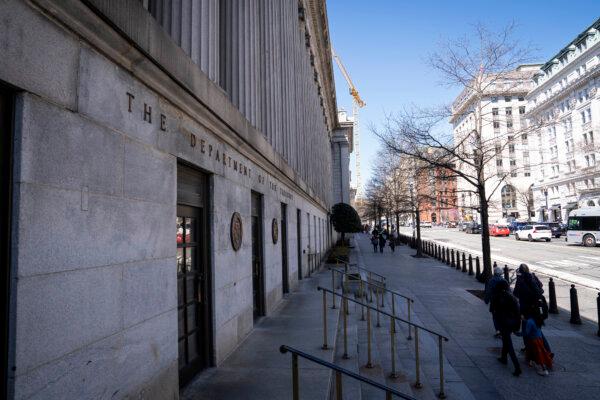Japan added billions to holdings while China reduced its exposure to U.S. government debt.
Foreign holdings of U.S. Treasury securities surged to an all-time high in August, data from the Treasury Department confirmed on Oct. 17.
Holdings of U.S. Treasurys increased to $8.5 trillion, up from $8.3 trillion in July and by nearly 12 percent from a year ago.
Japan remained the top holder of U.S. government debt, with Tokyo adding about $14 billion to $1.12 trillion.
China, the second largest holder of Treasurys, shed nearly $2 billion from its investment portfolio, lowering its stake to $774.6 billion. Beijing has engaged in a long-term crusade to decrease its exposure to U.S. Treasury debt, which has declined by approximately 4 percent since last year.
The UK is catching up to China, purchasing more than $15 billion in U.S. government debt for a total of $743.9 billion.
Other nations that added to their current holdings were France ($22 billion), Switzerland ($11 billion), Belgium ($9 billion), and India ($6 billion).
Canada and Germany were two of the three nations that trimmed their holdings, by $12 billion and $5 billion, respectively.
Foreign markets took advantage of T-bills—short-term debt securities ranging from four to 52 weeks—by buying $35 billion, bringing their total to $306.9 billion.
Yields on T-bills, from one month to one year, have been resilient even with the Fed cutting interest rates in September and planning to lower rates even more in the year ahead.
Over the past month, the overall Treasury market has trended upward, with the benchmark 10-year yield climbing by nearly 50 basis points to above 4 percent.
A part of the reason for the higher yields is that investors are resetting Federal Reserve policy expectations amid better-than-expected economic data, says Lawrence Gillum, the chief fixed income strategist for LPL Financial.
“Since Treasury yields have fallen recently alongside negative economic surprises, it isn’t surprising that yields are now moving higher given the better economic data and as fewer Federal Reserve rate cuts get priced into markets,” Gillum told The Epoch Times in an emailed note.
Another factor for elevated yields has been mixed Treasury auctions.
Demand for US Treasury Securities
The Treasury sold $22 billion in 30-year bonds on Oct. 10. Interest mostly came from indirect bidders—foreign entities that purchase these bonds through a primary dealer or a broker—while the direct bidders, comprising domestic financial institutions and individual investors, sat on the sidelines.
Foreign investors purchased about 78 percent of the supply. Primary dealers—companies that purchase the leftover supply—and direct bidders bought the remaining amount.
By the end of the auction, the high yield was 4.38 percent, up from 4.01 percent in the previous 30-year bond auction.

Comparable results were observed during the Oct. 9 $39 billion auction of 10-year Treasurys, with foreign investors buying about three-quarters of the supply. The high yield was 4.06 percent, up from 3.64 percent.
Althea Spinozzi, the head of fixed income strategy at Saxo Bank, says a large share of foreign investment demand is coming from European investors.
“The upcoming 5- and 7-year U.S. Treasury auctions are expected to attract strong demand, particularly from European investors, as these notes offer a yield premium over German sovereigns when hedged against the euro,” Spinozzi said in a note last month.
“While U.S. Treasuries remain unattractive for Japanese investors due to deeply negative yields once hedged against the yen, increased demand from European investors is likely to offset concerns about the large issuance volumes.”
Auctions over the past year have revealed consternation surrounding the U.S. government’s fiscal health.
In 2023, Washington received a pair of rating outlook downgrades from Fitch Ratings and Moody’s.
“The rating downgrade of the United States reflects the expected fiscal deterioration over the next three years, a high and growing general government debt burden, and the erosion of governance relative to ‘AA’ and ‘AAA’ rated peers over the last two decades that has manifested in repeated debt limit standoffs and last-minute resolutions,” Fitch analysts said in August 2023.
US Debt Keeps Growing
Later this month, the Treasury Department will announce its borrowing estimates for the next six months.
In July, officials projected that the federal government would borrow $1.3 trillion in the second half of 2024: $740 billion in the July to September period and $565 billion in the October to December quarter.
According to the Treasury’s debt-to-the-penny dashboard, the United States has borrowed nearly $500 billion in the past three weeks, with the national debt reaching $35.74 trillion as of Oct. 16.
While the Treasury has delayed publishing the final budget numbers for fiscal year 2024, the Congressional Budget Office estimates that the federal deficit was more than $1.8 trillion.
Additionally, the nonpartisan budget watchdog noted that the budget shortfall would have been 13 percent higher—instead of 8 percent larger—from the previous fiscal year if it were not for timing shifts for certain payments.
“With one fiscal year ending and another starting anew, it’s clear that we have a lot of course correcting to do. We’re now borrowing $5 billion per day, while interest payments are soaring,” Maya MacGuineas, president of the Committee for a Responsible Federal Budget, said in a statement.
“At nearly $2 trillion, last year’s deficit was almost double pre-pandemic levels. We face massive headwinds with debt set to reach an all-time record as a share of the economy by 2027; and we don’t even have a plan to address our fiscal challenges.”

